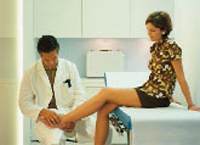Ensure a lifetime of mobility with these simple foot facts.
 Given that the foot has 26 bones, 33 joints and more than 100 tendons, muscles and ligaments, it’s no wonder so much can go wrong with this body part. In fact, there are more than 300 possible foot ailments. Since your feet need to last you a lifetime, preventive foot care — and early attention to foot problems — should be a top concern. Here’s what you need to know about podiatry.
Given that the foot has 26 bones, 33 joints and more than 100 tendons, muscles and ligaments, it’s no wonder so much can go wrong with this body part. In fact, there are more than 300 possible foot ailments. Since your feet need to last you a lifetime, preventive foot care — and early attention to foot problems — should be a top concern. Here’s what you need to know about podiatry.
1. Foot problems can be grouped according to age and stage of development. In children the problem might be flat feet or walking with an “in-toeing” (pigeon-toed) gait. Warts and ingrown toenails are another common complaint of kids. In addition to warts, adults come in with athlete’s foot, fungal infections and structural problems such as bunions, hammertoes (where the toes contract as a result of an imbalance between tendons on the top and the bottom of the toe), heel spurs (growths on the underside of the heel bone) or neuromas (overgrowth of nerves around the bones). With seniors podiatrists help maintain good foot care. They can’t bend down and remove calluses or they develop very thick toenails, and they may have arthritis or issues with their eyesight.
2. Regular foot care is extremely important for people with diabetes. They may experience a loss of sensation (neuropathy) in their feet or develop sores, which can become seriously infected. Unfortunately, foot and leg amputations among people with diabetes are all too common. Proper patient education and proper shoes for people with diabetes are essential.
3. Orthotics (shoe inserts) can solve many foot problems, especially in children. Orthotics help correct an abnormal gait by altering the alignment between the foot and the lower leg. These shoe inserts are used to treat such problems as plantar fasciitis (an inflammation of the long band of connective tissue running from the heel to the ball of the foot resulting in arch and heel pain), heel spurs and overpronation (in which the foot rolls inward too much when walking). They also prevent problems affecting other areas of the body, such as “runner’s knee” (pain beneath or on the sides of the kneecap caused by wear and tear on the cartilage under it). Orthotics may also correct flat feet in young children. Either custom-made or bought over-the-counter in a drugstore, orthotics may be rigid, semirigid or soft. If custom-made, they are usually made from a mould of the person’s foot.
Basic foot care tips
- Inspect your feet regularly. Discoloured or thickened nails may be a sign of a fungal infection, while peeling or scaling on the soles of the feet might signal athlete’s foot.
- Wash feet regularly and dry them thoroughly, especially between the toes.
- Trim toenails straight across, not too short and not in corners or on the sides, to prevent ingrown toenails.
- Make sure shoes fit properly. Buy new ones later in the day when feet are at their largest.
- Avoid high heels; they contribute to knee and back problems and may cause structural changes in feet that make walking permanently painful. If you must wear high heels, alternate them with more comfortable flats.
- Avoid wearing panty hose for lengthy periods; your feet may get overheated, which encourages fungal infections.
